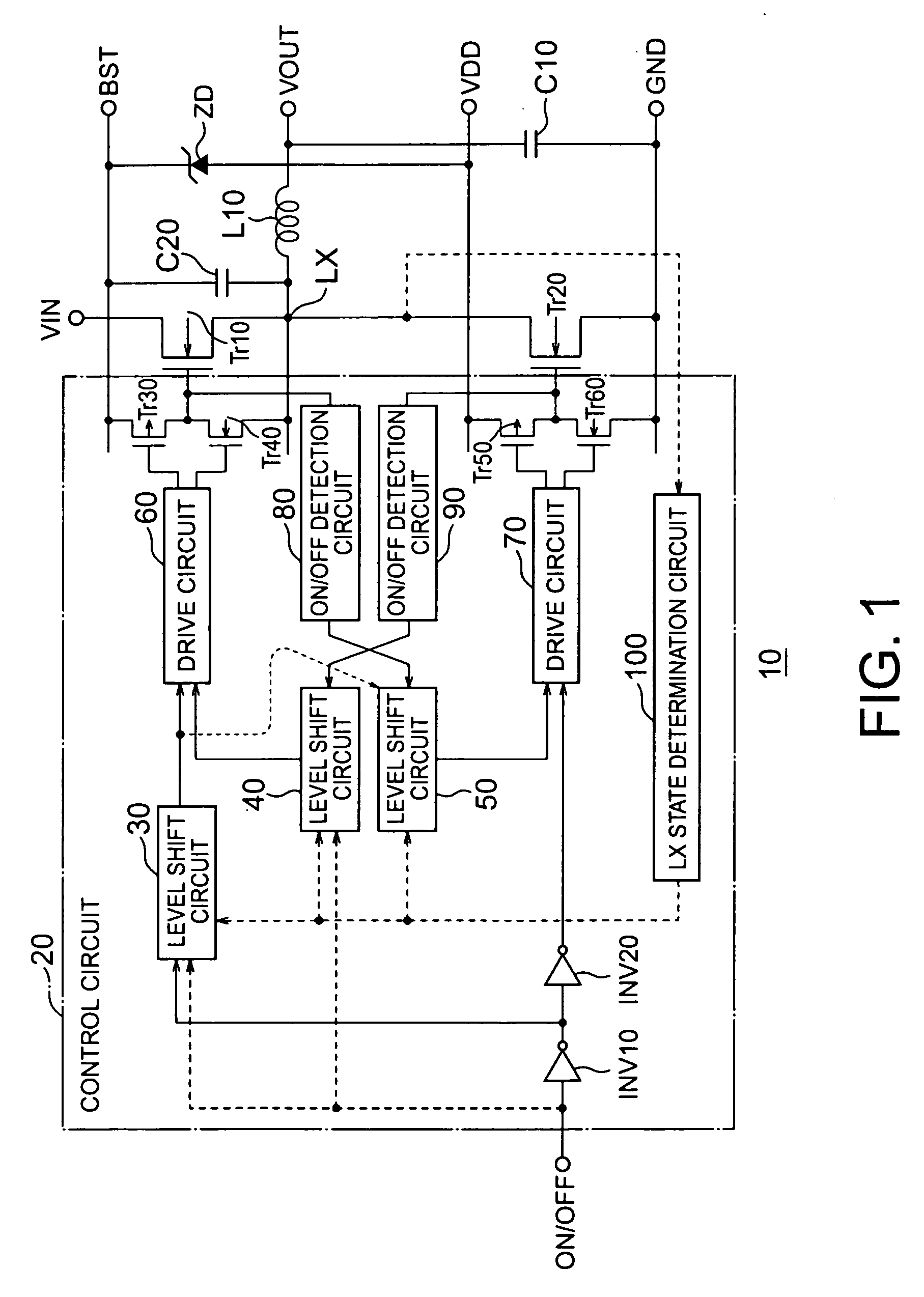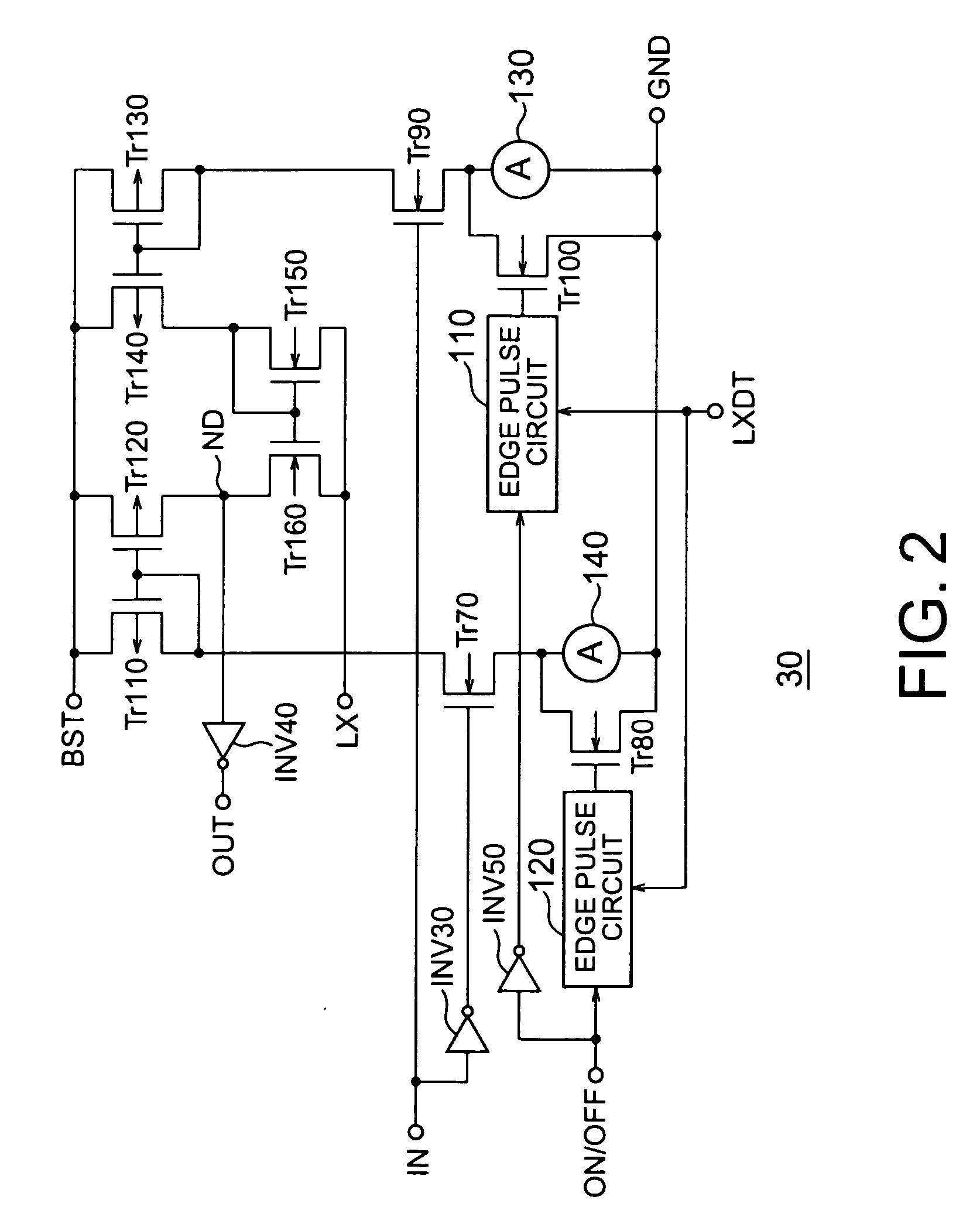Semiconductor device
a technology of semiconductors and devices, applied in the direction of pulse techniques, power conversion systems, instruments, etc., can solve the problems of increasing circuit scale and current consumption
- Summary
- Abstract
- Description
- Claims
- Application Information
AI Technical Summary
Benefits of technology
Problems solved by technology
Method used
Image
Examples
first embodiment
(1) First Embodiment
[0014]FIG. 1 shows the configuration of a DC-DC converter 10 according to a first embodiment of the present invention. The DC-DC converter 10 generates a desired level of DC voltage by converting a DC voltage input from a voltage input terminal VIN into a high-frequency AC voltage and smoothing the AC voltage and outputs the DC voltage from a voltage output terminal VOUT.
[0015] The DC-DC converter 10 has NMOS transistors Tr10 and Tr20 as switching elements. A source of the NMOS transistor Tr10 and a drain of the NMOS transistor Tr20 are connected, a drain of the NMOS transistor Tr10 is connected to the voltage input terminal VIN, and a source of the NMOS transistor Tr20 is connected to a ground terminal GND.
[0016] The DC-DC converter 10 alternates the operation of turning on or off the NMOS transistors Tr10 and Tr20 with the reverse operation such that if an NMOS transistor Tr, one of the NMOS transistors Tr10 and Tr20 is brought into an off state, the other NM...
second embodiment
(2) Second Embodiment
[0089]FIG. 6 shows the configuration of a DC-DC converter 300 according to a second embodiment of the present invention. Note that the same components as those shown in FIG. 1 are denoted by the same reference numerals and that an explanation thereof will be omitted. Level shift circuits 320 to 340 have the same configurations as the corresponding level shift circuits 30 to 50 (FIGS. 2 and 5) except for edge pulse circuits.
[0090] The potential of a node LX changes in response to a change in signals indicating the connection states of NMOS transistors Tr10 and Tr20 output from on / off detection circuits 80 and 90. Accordingly, in this embodiment, each of the level shift circuits 320 to 340 determines a time when an increased driving current is decreased using a signal notifying, of the connection state of one of the NMOS transistors Tr10 and Tr20, a drive circuit 70 or 60 for driving the other NMOS transistor Tr20 or Tr10, i.e., a signal output from the on / off de...
third embodiment
(3) Third Embodiment
[0102]FIG. 7 shows the configuration of a DC-DC converter 400 according to a third embodiment of the present invention. Note that the same components as those shown in FIG. 1 are denoted by the same reference numerals and that an explanation thereof will be omitted.
[0103] In this embodiment, a control circuit 410 has a drive circuit 480 for driving a PMOS transistor Tr50 and a drive circuit 490 for driving an NMOS transistor Tr60.
[0104] The drive circuits 480 and 490 are powered by different power sources. The drive circuit 490 uses, as a reference potential, 0 V, i.e., a low reference potential while the drive circuit 480 uses, as a reference potential, a potential between one applied from a power supply terminal VDD and 0 V (to be referred to as an intermediate reference potential hereinafter).
[0105] This makes it possible to increase the gate threshold voltage of an NMOS transistor Tr20 while maintaining the withstand voltages of the drive circuits 480 and ...
PUM
 Login to View More
Login to View More Abstract
Description
Claims
Application Information
 Login to View More
Login to View More - R&D
- Intellectual Property
- Life Sciences
- Materials
- Tech Scout
- Unparalleled Data Quality
- Higher Quality Content
- 60% Fewer Hallucinations
Browse by: Latest US Patents, China's latest patents, Technical Efficacy Thesaurus, Application Domain, Technology Topic, Popular Technical Reports.
© 2025 PatSnap. All rights reserved.Legal|Privacy policy|Modern Slavery Act Transparency Statement|Sitemap|About US| Contact US: help@patsnap.com



